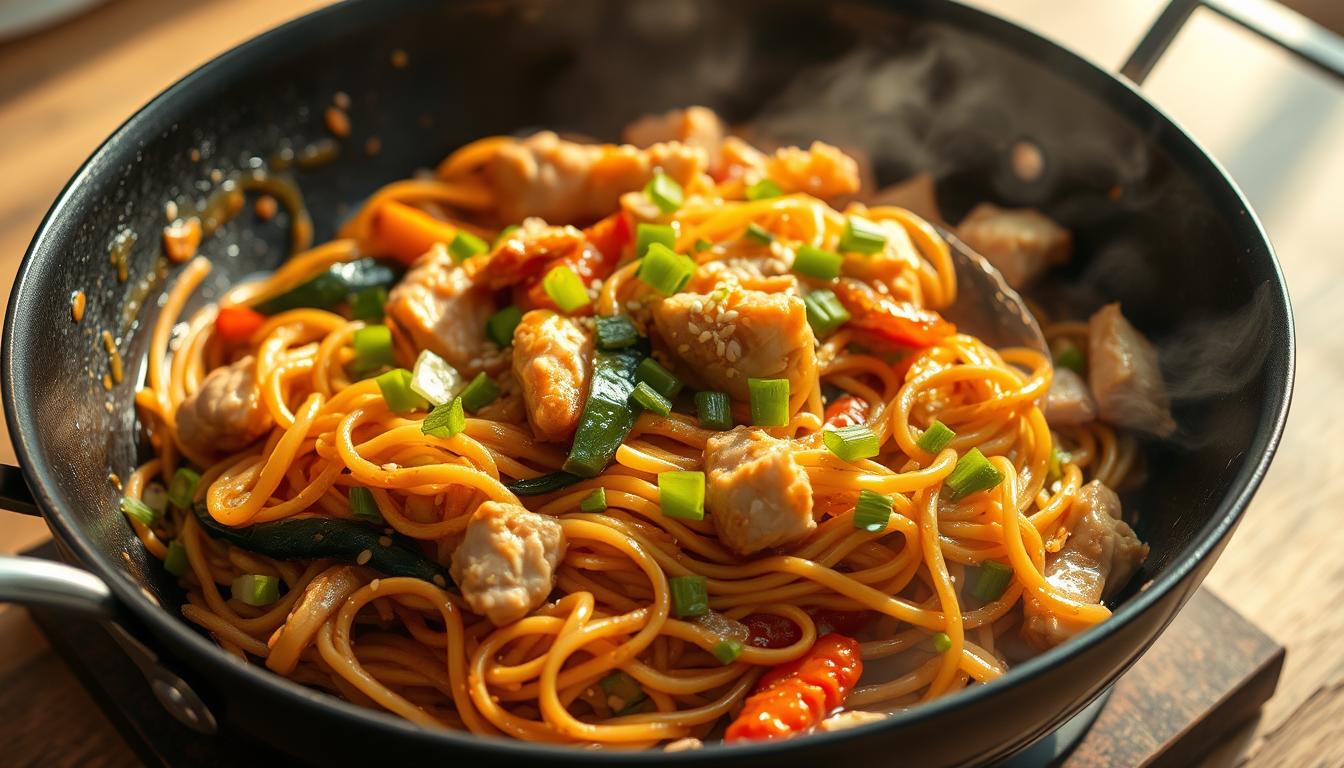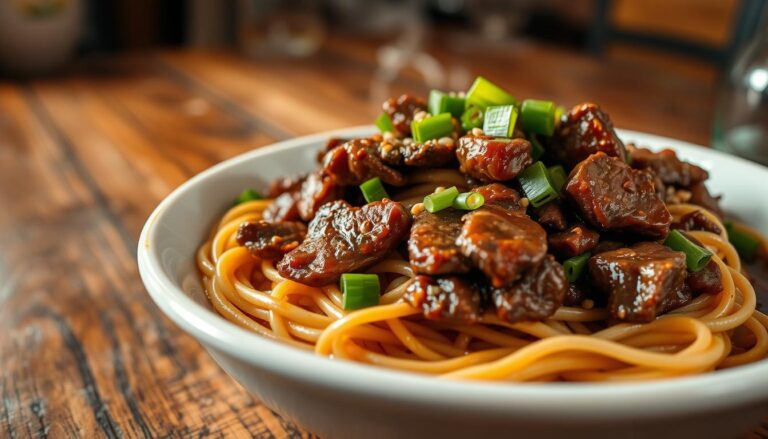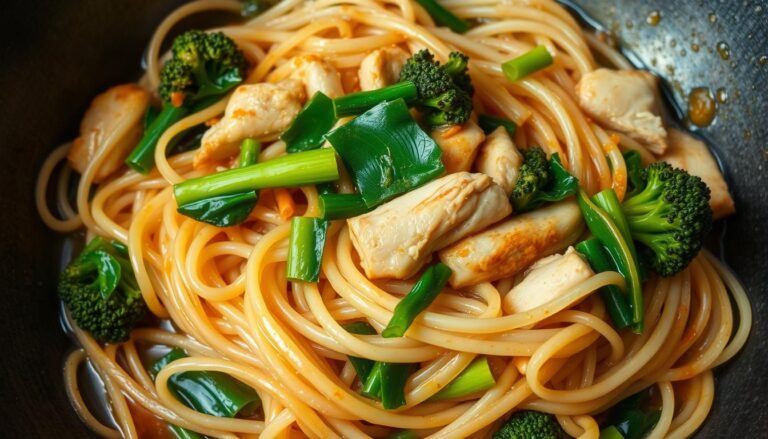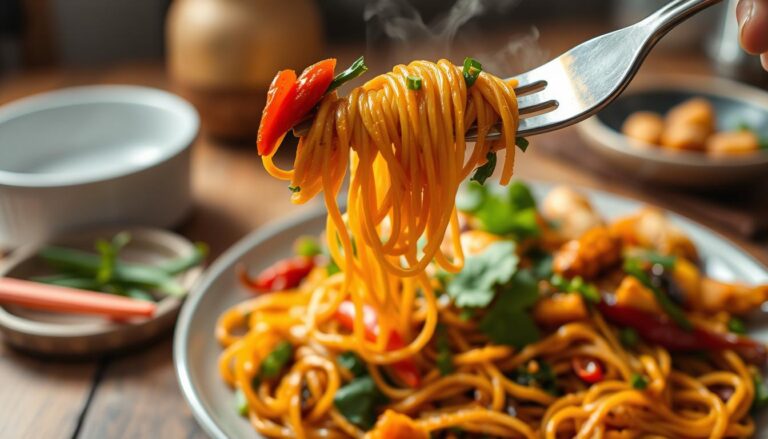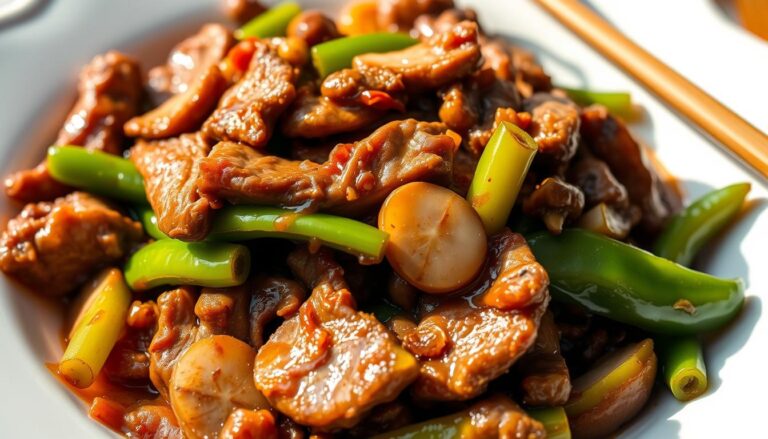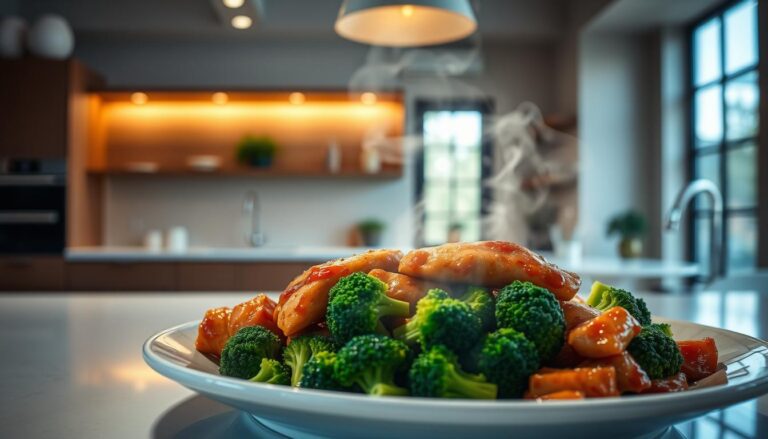Quick Chicken-Ramen-Stir-Fry: Delicious Dinner Idea
Craving a meal that’s fast, flavorful, and fuss-free? This chicken-ramen-stir-fry reinvents instant noodles into a vibrant dish bursting with fresh flavors. Perfect for busy weeknights, it swaps processed seasoning packets for a savory homemade sauce that lets you control the taste without sacrificing speed.
Using everyday ingredients like ground chicken and coleslaw mix, this recipe maximizes convenience without skimping on nutrition. A large skillet ensures your veggies wilt evenly while the protein cooks to tender perfection. You’ll also learn why properly boiling ramen noodles separately keeps them springy and prevents sogginess.
The magic lies in balancing salty, sweet, and umami notes. A splash of soy sauce adds depth, while fresh garlic or ginger brightens each bite. Ready in under 30 minutes, this dish proves quick meals don’t have to mean bland or boring.
Key Takeaways
- Transform instant ramen into a gourmet stir-fry using fresh ingredients.
- Skip pre-made flavor packets for a customizable homemade sauce.
- Use a large skillet to evenly cook vegetables and chicken.
- Ground chicken and coleslaw mix save prep time without compromising taste.
- Soy sauce and fresh aromatics create a well-rounded flavor profile.
- Cook ramen noodles separately to maintain ideal texture.
- Ideal for hectic evenings when you need dinner fast.
Introduction and Recipe Overview
Want to turn pantry staples into something extraordinary? This dish reimagines ramen noodles by pairing them with juicy chicken and crisp vegetables. You’ll discover how simple swaps like fresh garlic and a tangy homemade glaze transform basic ingredients into a vibrant meal.
The magic starts with ditching pre-packaged seasoning. Store-bought mixes often contain excess sodium and artificial flavors. Instead, whisk together soy sauce, rice vinegar, and a touch of honey. This creates a balanced sauce that coats every strand of noodle without overpowering the dish.
Texture plays a starring role here. Quick-cooked cabbage or coleslaw mix adds crunch, while properly boiled ramen stays springy. Ground chicken browns evenly in minutes, making it ideal for weeknights. Three elements make this recipe stand out:
- Fresh aromatics (garlic, ginger) for brightness
- Separately cooked noodles to avoid mushiness
- High-heat sautéing to caramelize veggies
You’ll love how customizable this base is. Swap bell peppers for snap peas or add chili flakes for heat. The key is maintaining the harmony between savory, sweet, and umami notes. Ready in under 30 minutes, it’s proof that fast meals can still feel gourmet.
Essential Ingredients and Kitchen Tools
Gathering the right components ensures your dish shines. Freshness matters: minced garlic, grated ginger, and crisp vegetables like shredded cabbage or snap peas add vibrant texture. For the sauce, combine soy sauce, honey, and rice vinegar – this trio balances salty, sweet, and tangy notes perfectly.
Homemade Sauce Components and Fresh Additions
Skip store-bought mixes. Whisk 3 tablespoons soy sauce, 1 tablespoon honey, and 2 teaspoons rice vinegar. Add minced garlic and ginger for aromatic depth. This blend takes under 5 minutes to prepare but elevates flavor dramatically. For crunch, toss in coleslaw mix or thinly sliced bell peppers.
Must-Have Utensils and Large Skillet Tips
A 12-inch skillet is non-negotiable. Its wide surface lets ingredients cook evenly without steaming. Preheat it over medium-high heat before adding oil – this prevents sticking. Use tongs or a wooden spatula to stir ingredients quickly, ensuring they don’t overcook.
Key tools to streamline your process:
- Chef’s knife for chopping veggies
- Measuring spoons for precise sauce ratios
- Colander for draining noodles efficiently
With these items ready, you’ll spend less time prepping and more time enjoying your meal.
Step-by-Step Cooking Process
Transform basic ingredients into a restaurant-worthy dish through precise techniques. Follow these methods to lock in flavor while keeping your protein tender and vegetables crisp.
Cooking the Chicken and Sautéing Vegetables
Heat 1 tablespoon oil in your skillet over medium-heat. Add ground chicken, breaking it apart with a spatula. Cook until no pink remains – about 5 minutes. Excess fat can be drained for a lighter meal.
Toss in coleslaw mix or sliced veggies. Increase heat to high for 90 seconds. This quick sear caramelizes edges while preserving crunch. Stir constantly to prevent burning.
Perfecting the Ramen Noodles and Sauce Integration
Boil noodles separately until al dente. Reserve ½ cup starchy water before draining. This liquid helps sauce cling to every strand.
Return skillet to medium heat. Pour in your homemade sauce and noodles. Toss vigorously, adding reserved water 1 tablespoon at a time. Finish with 1 teaspoon sesame oil for nutty aroma.
- Mix noodles within 30 seconds to avoid sogginess
- Adjust sauce thickness with more water or oil
- Garnish with toasted sesame seeds for texture
Master Your Chicken-Ramen-Stir-Fry
Unlock restaurant-quality results at home by mastering these essential cooking strategies. Precision and smart ingredient management turn this quick dinner into a flavor-packed experience worth repeating.
Key Techniques for Quick, Flavorful Results
Control texture by covering your skillet briefly after adding vegetables. This traps steam to soften peppers or cabbage slightly while preserving crunch. Remove the lid after 90 seconds to prevent sogginess.
Ditch pre-made seasoning packets to slash sodium and calories. Instead, use reserved noodle water to thin your sauce naturally. Its starchiness helps flavors cling to every ingredient without added thickeners.
Assess doneness by testing vegetables and protein separately. Peppers should snap lightly when pressed, while chicken must reach 165°F. Stir components gently to distribute heat evenly without breaking delicate noodles.
Fine-tune flavors at the finish:
- Add lime juice to brighten heavy sauces
- Swap honey for chili paste to boost heat
- Sprinkle sesame seeds for nutty depth
Time each element using staggered starts. Begin boiling noodles first, then prep vegetables while chicken cooks. This synchronization ensures everything hits the skillet at its peak.
Creative Variations and Expert Tips
Elevate your weeknight rotation with endless ways to personalize this adaptable dish. Whether you’re craving fiery heat or a veggie-packed meal, these tweaks ensure every bite matches your preferences.
Tailor Heat and Vegetable Combinations
Adjust spice levels effortlessly. Add ½ teaspoon red pepper flakes while sautéing garlic cloves, or drizzle Sriracha over finished servings. For milder palates, swap chili paste for honey-glazed carrots.
Mix up vegetables based on seasonality. Thinly sliced bell peppers add crunch, while bok choy wilts beautifully into the sauce. Always prep veggies uniformly to ensure even cooking times.
Protein Swaps and Dietary Adjustments
Replace ground chicken with cubed tofu or shrimp for variety. Press tofu for 10 minutes to remove excess moisture—this helps it crisp up during cooking. For lower sodium options, use reduced-salt soy sauce.
Gluten-free? Swap instant ramen noodles for rice noodles or zucchini spirals. Maintain portion control by measuring servings before adding extras like nuts or avocado slices.
“The beauty of this recipe lies in its flexibility—treat it as a canvas for your favorite flavors.”
Double prep batches of minced garlic and ginger to streamline future meals. Store them in ice cube trays with olive oil for quick access. Always taste and adjust seasoning after swapping ramen noodle types, as cooking times vary.
Conclusion
Revamping pantry staples into gourmet meals is simpler than you think. This recipe transforms instant ramen into a restaurant-worthy dish by harnessing high heat to caramelize flavors and retain crisp textures. Timing matters—searing veggies quickly locks in freshness while keeping your meal vibrant.
Finish strong with final touches: sprinkle green onions for color and extra cloves garlic for aromatic depth. These garnishes elevate presentation while adding layers of flavor. Store-bought seasoning packets can’t compete with this balanced, homemade approach.
Flexibility is key. Swap in snow peas for crunch or add sauce gradually to control richness. Want more noodles? Add noodles reserved from earlier steps to bulk up portions without diluting taste.
With these techniques, even leftovers shine. Reheat gently using high heat to revive textures. Whether it’s your first attempt or fifth, this instant ramen blueprint guarantees a satisfying meal tailored to your cravings.
FAQ
Can I use a different protein instead of chicken?
Yes! Shrimp, tofu, or thinly sliced beef work well. Adjust cooking times based on your protein choice. Sear meats on high heat for optimal texture.
How do I avoid overcooking ramen noodles?
Cook noodles just until tender (2-3 minutes). Rinse with cold water to stop the cooking process. Add them to the skillet last to maintain chewiness.
What’s a low-sodium substitute for soy sauce?
Try coconut aminos or reduced-sodium soy sauce. Adjust seasoning packets carefully, as they often contain high salt content.
Can I make this gluten-free?
Absolutely. Use gluten-free ramen noodles (like Lotus Foods) and tamari instead of regular soy sauce. Check seasoning packets for hidden gluten.
Which veggies add the best crunch?
Bell peppers, snap peas, or shredded cabbage work great. Sauté them briefly on high heat to retain texture without losing color.
How long do leftovers stay fresh?
Store in an airtight container for up to 3 days. Reheat in a skillet with a splash of water to revive the noodles’ texture.
Can I prep the sauce in advance?
Yes! Mix soy sauce, sesame oil, and garlic ahead of time. Store it refrigerated for up to 5 days. Shake well before using.

